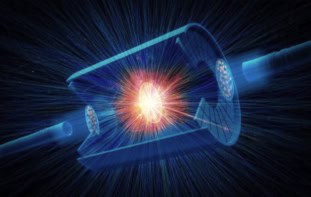
A new algorithmic technique could enhance the output of fusion reactors by smoothing out the laser pulses used to compress hydrogen to fusion densities. Developed by physicists at the University of Bordeaux, France, a simulated version of the new technique has already been applied to conditions at the US National Ignition Facility (NIF) and could also prove useful at other laser fusion experiments.
A major challenge in fusion energy is keeping the fuel – a mixture of the hydrogen isotopes deuterium and tritium – hot and dense enough for fusion reactions to occur. The two main approaches to doing this confine the fuel with strong magnetic fields or intense laser light and are known respectively as magnetic confinement fusion and inertial confinement fusion (ICF). In either case, when the pressure and temperature become high enough, the hydrogen nuclei fuse into helium. Since the energy released in this fusion reaction is, in principle, greater than the energy needed to get it going, fusion has long been viewed as a promising future energy source.
In 2022, scientists at NIF became the first to demonstrate “energy gain” from fusion, meaning that the fusion reactions produced more energy than was delivered to the fuel target via the facility’s system of super-intense lasers. The method they used was somewhat indirect. Instead of compressing the fuel itself, NIF’s lasers heated a gold container known as a hohlraum with the fuel capsule inside. The appeal of this so-called indirect-drive ICF is that it is less sensitive to inhomogeneities in the laser’s illumination. These inhomogeneities arise from interactions between the laser beams and the highly compressed plasma produced during fusion, and they are hard to get rid of.
In principle, though, direct-drive ICF is a stronger candidate for a fusion reactor, explains Duncan Barlow, a postdoctoral researcher at Bordeaux who led the latest research effort. This is because it couples more energy into the target, meaning it can deliver more fusion energy per unit of laser energy.
Reducing computing cost and saving time
To work out which laser configurations are the most homogeneous, researchers typically use iterative radiation-hydrodynamic simulations. These are time-consuming and computationally expensive (requiring around 1 million CPU hours per evaluation). “This expense means that only a few evaluations were run, and each step was best performed by an expert who could use her or his experience and the data obtained to pick the next configurations of beams to test the illumination uniformity,” Barlow says.
The new approach, he explains, relies on approximating some of the laser beam-plasma interactions by considering isotropic plasma profiles. This means that each iteration uses less than 1000 CPU, so thousands can be run for the cost of a single simulation using the old method. Barlow and his colleagues also created an automated method to quantify improvements and select the most promising step forward for the process.
The researchers demonstrated their technique using simulations of a spherical target at NIF. These simulations showed that the optimized configuration should produce convergent shocks in the fuel target, resulting in pressures three times higher (and densities almost two times higher) than in the original experiment. Although their simulations focused on NIF, they say it could also apply to other pellet geometries and other facilities.
Developing tools
The study builds on work by Barlow’s supervisor, Arnaud Colaïtis, who developed a tool for simulating laser-plasma interactions that incorporates a phenomenon known as cross-beam energy transfer (CBET) that contributes to inhomogeneities. Even with this and other such tools, however, Barlow explains that fusion scientists have long struggled to define optical illuminations when the system deviates from a simple mathematical description. “My supervisor recognized the need for a new solution, but it took us a year of further development to identify such a methodology,” he says. “Initially, we were hoping to apply neural networks – similar to image recognition – to speed up the technique, but we realized that this required prohibitively large training data.”

Laser fusion output is tripled by new computer algorithm
As well as working on this project, Barlow is also involved in a French project called Taranis that aims to use ICF to produce energy – an approach known as inertial fusion energy (IFE). “I am applying the methodology from my ICF work in a new way to ensure the robust, uniform drive of targets with the aim of creating a new IFE facility and eventually a power plant,” he tells Physics World.
A broader physics application, he adds, would be to incorporate more laser-plasma instabilities beyond CBET that are non-linear and normally too expensive to model accurately with radiation-hydrodynamic simulations. Some examples include simulated Brillouin scattering, stimulated Raman scattering and two-plasmon decay. “The method presented in our work, which is detailed in Physical Review Letters, is a great accelerated scheme for better evaluating these laser-plasma instabilities, their impact for illumination configurations and post-shot analysis,” he says.



